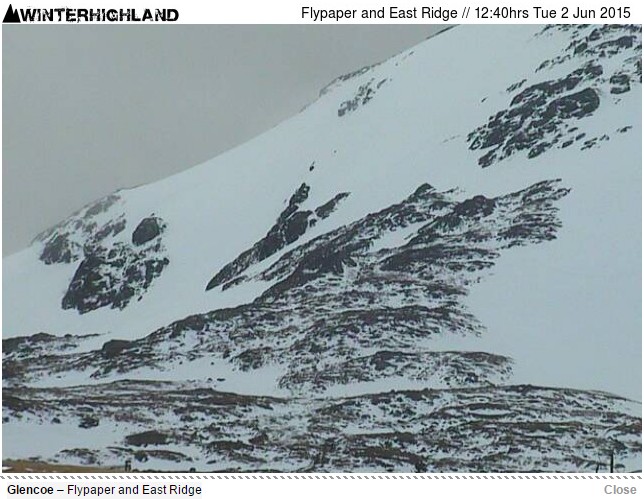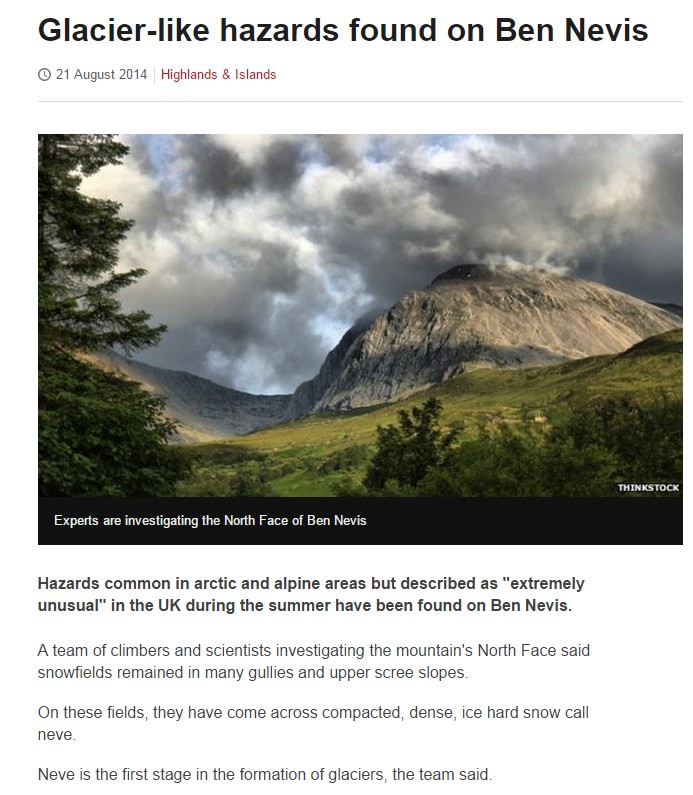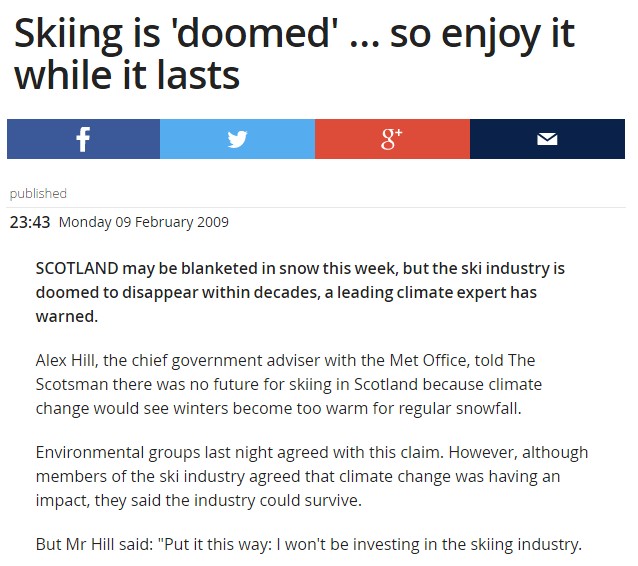This is what Scotland looked like yesterday
Last summer, the BBC reported the early stages of glacier formation in Scotland
Six years ago, the Met Office warned that Scottish skiing is doomed
Skiing is ‘doomed’ … so enjoy it while it lasts – The Scotsman
Fifteen years ago, CRU warned that children won’t know what snow is
According to Dr David Viner, a senior research scientist at the climatic research unit (CRU) of the University of East Anglia,within a few years winter snowfall will become “a very rare and exciting event”.
“Children just aren’t going to know what snow is,” he said.
Snowfalls are now just a thing of the past – Environment – The Independent
Climate experts understand nothing about the climate. They simply look for any isolated evidence or short term trends which supports their ongoing funding.






I share your concern that children of the future will not know honest science and wrote this one-page introduction to “Science for Teachers” to by-pass official gatekeepers of scientific knowledge:
https://dl.dropboxusercontent.com/u/10640850/Introduction.pdf
A few prominent physicists are finally starting to speak out.
http://junkscience.com/2015/06/03/prominent-physicists-accuse-american-physical-society-of-misconduct-in-drafting-upcoming-global-warming-statement/
Stalin apparently tricked physicists into thinking they were “saving the world from nuclear annihilation” by inserting falsehoods into the very foundations of physics in 1946.
I wathc it with “Junk Science’s” website. They DO have a lot of propaganda too. – Just like trying to push that MONSANTO’s “Round-Up” is “safe” and not carcinogenic (despite the fact that there is a plethora of evidence to the contrary, not necessarily from just the “lefty” sites).
Hi Dr Omanuel, sorry to veer off topic but what are your opinions on Galen Winsor? Your drop box contributions have led me off in many different directions and one of those led me to a one and a half hour talk by him.
Thanks.
Keith0,
I do not know for certain, but I strongly suspect that Galen Winson is telling the truth as he knows it in “The Nuclear Scare Scam.”
https://m.youtube.com/watch?v=ejCQrOTE-XA&feature=player_embedded
I know for certain Hiroshima and Nagasaki recovered and became bustling cities after being destroyed by atomic bombs on August 6 and 9, 1945.
Thank you for responding. I watched the lecture and found it very convincing, particularly after all the things I learned from a lot of very knowledgeable fellows during and after the Fukushima event.
Yes, Keitho, FEAR appears to have been used to enslave the public after WWII.
Nuclear energy is the creator, destroyer and sustainer of every atom, life and world as the universe expands, entropy increases, and neutrons become hydrogen atoms.
Today Steve Milloy correctly identified Harvard University’s science.
http://junkscience.com/2015/06/04/harvard-syracuse-researchers-caught-lying-to-boost-obama-climate-rules/
I deeply regret that blunt statements may be necessary to restore sanity to society and reverse the corruption of science.
Are we looking at this backwards? Warmies are big on the fantasy positive feedback loop of heat. Not being a science guy, but being from a cold climate i can tell you this… it is very hard to melt snow and ice. Ambient temperature over snow/ice is dramatically colder than bare ground. My point is on a large scale; does ice generate cold temps and thus more snow/ice in a positive feedback? IE Glaciation?
Ambient temperature over snow/ice is colder than bare ground? That is unless the Ambient temp is well below freezing. Then I prefer a snow cave or snow trench for shelter from the cold rather than a tent or bivisack on the snows surface. Lots warmer.
Of course,
Isn’t that why igloos were used as shelter in the perma-frost regions?
Hmmm.
Igloos work on the same principle as snow caves. The ice or snow is warmer than the air and traps the heat inside. The smooth and curved surface inside allows the natural melt to run down the walls to a trench formed in the ice or snow to channel it away from the sleeping/living area. A cold well is formed near the entrance below the sleeping/living area so the cold air has a place to flow and to help prevent cold air blowing in the entrance. The domes of both shelter types are vented to allow CO2 from breathing and CO from combustion to escape.
I have lived comfortably in a snow cave for days at a time in sub zero weather. When I attended the Norwegian Army winter warfare school we stayed in a multi-room snow cave that would house an entire company of soldiers.
That I am aware of (since childhood). The surrounding air being what helps keep the icy structure intact – even in spite of the warmer air inside (from being occupied by its inhabitants). What a lot of the “warmists” also seem to forget, is that it is mostly the air temperatures that change far faster and more frequently than the surface temperatures do. This is because the ground is more dense in which retards and/or impedes the flow of infrared energy (typically – heat), as opposed to the lesser density of air which is also more “fluid”. This also accounts for why the changes in interior temperatures of subterranean homes will often lag the changes in temperatures of the air by at least a month. (IE: Seasonal temperature changes.) So, it is easily evident that many of the cult “warmists” really need to do more of their homework!
– Thank you.
An ice cap could start to form on the Nunavut mainland in Canada and Dr. John Holdren would tell us that the odds are that what we can expect as a result of global warming is to see more of this pattern ice cap formation.
And they would invent 7 different reasons why global warming causes glaciers to form in Scotland.
Here is letter of dissenting physicists:
https://junksciencecom.files.wordpress.com/2015/06/letter-to-president-of-american-physical-society_aps-integrity-issues.pdf
Hah-hah-hah!
Choice word: “invent”. THAT, they do!
Steve–I grew up just west of where you live now (was in the Merton/Hartland area). For all of us, glaciers were sources of wonderment and obviously had a huge impact on the local topography (lakes, kettles, drumlins, moraines, etc.). To your point about Nunavut–at the end of the last glacial period, the Laurentide Ice Sheet retreated back to its source in the Baffin Island area, where the Barnes Ice Cap still can be found. People seem to think that glaciers started from the ground up across the whole glaciated area, when in fact (as we see from the striations in the Canadian Shield and moraines in Wisconsin) they scraped their way down from Nunavut. If we want a good barometer of whether we are re-entering a glacial epoch, we should monitor the Barnes Ice Cap in real-time–and I’m not aware of any person/team doing this. For the glaciers to advance to Wisconsin, they must have accumulated such mass on Nunavut/Ontario that they were pushed in that direction. This requires a tremendous mechanism to drive ongoing snowfall over Nunavut (in excess of the melt rates across the whole of the ice field). Thus, I am still sympathetic to at least portions of the Ewing-Donn theory, as open water provides a source of moisture.
Thanks for the post, I’ve been to Merton a few times, it’s hard to find (-:
Lots of glacial remnants the Wisconsin landscape, eskers , drumlins etc. My favorite is the Hogs back road in Hubertus.
I also think that the Barnes Ice Cap is the thing to watch. Last year it was covered completely in new snow on 14 August which then remained for the rest of the season. There was some melting around the periphery of the ice cap but in mid-September even the land surrounding the ice cap was snow covered. By mid-October the peripheral meltwater lakes were also all frozen.
http://www.arctic.io/explorer/
In 2013 the Barnes Ice Cap was completely covered with new snow on 26 August.
I think It would be nice if glaciers started forming in Qatar, then it would be cooler for the 2022 football world cup. 🙂
Reblogged this on Climate Collections.